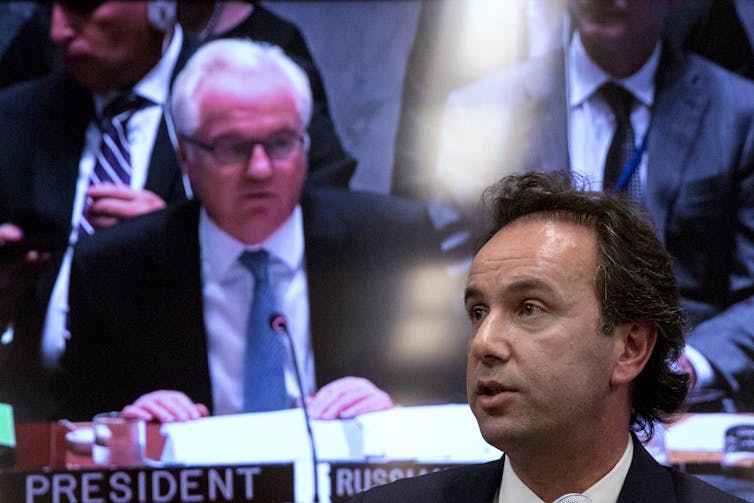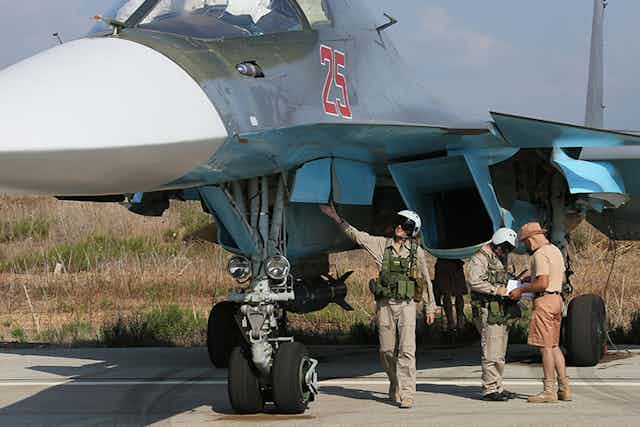This article was updated on October 8 to reflect the latest developments.
All eyes are on the skies above Syria which have become the potential flashpoint for conflict between Russia and the West after Russian aircraft conducting airstrikes against anti-Assad rebels reportedly violated Turkish airspace, raising the possibility of NATO getting drawn into a rapidly escalating crisis.
NATO secretary-general Jens Stoltenberg issued a warning to Russia that it was taking the situation seriously and had already responded by increasing its capacity and readiness to deploy forces – including in Turkey.
NATO is ready and able to defend all allies, including Turkey against any threats … In Syria, we have seen a troubling escalation of Russian military activities. We will assess the latest developments and their implications for the security of the alliance. This is particularly relevant in view of the recent violations of NATO’s airspace by Russian aircraft.
Stoltenberg’s warning came as the British foreign secretary, Michael Fallon, announced the deployment of troops to Baltic countries to shore up NATO’s eastern defences in the face of Russian military incursions in Ukraine.
Russia’s decision to conduct airstrikes in Syria follows a summer of fruitless and inconsequential diplomacy and raises important questions about who is bombing who and what these campaigns aim to achieve.
So who’s flying what?
At the beginning of the war, the Syrian Arab Air Force (SyAAF) was able to use its overwhelming air superiority to bomb rebel positions but developments have affected the Syrian military’s air status and have made the Russian intervention much more important for the Assad regime.
Firstly, parts of the war have moved into major urban areas where air superiority is of less tactical use, though the use of barrel bombs from Syrian helicopters still regularly make the news. Secondly, many Syrian airbases, for both fighter planes and helicopters have been captured and destroyed, which has had a major impact on the ability of Assad forces to hold territory.
Prior to the capture or destruction of air bases in Syria, the SyAAF was flying MiG-21s, MiG-23BNs, Su-22s and a few Su-24s, all fighter and bomber aircraft that are used by most other Arab countries not under the patronage of United States defence assistance.
The United States and its allies in the region began to target IS positions in Syria in August 2014, following a similar pattern used in Iraq. With the United States over Syria are six other countries: Bahrain, Jordan, Qatar, Saudi Arabia, United Arab Emirates – and the United Kingdom. Other countries, such as Turkey and France, are also targeting IS from outside the official coalition and others such as The Netherlands and Australia have limited their operations to Iraq.
The US-led coalition has refrained from directly targeting Syrian pro-government forces while primarily defending Kurdish positions and attacking supply lines. In addition to traditional air forces, the US, UK and many others are using drones over Syria as have the Iranians, and more recently – according to some reports – IS itself.
With the US-led intervention, it could be taken that as well as the Kurdish forces, moderate rebel forces, such as the Free Syrian Army, also had air support while the SyAAF continued to experience a decline in numbers and operational opportunities.
The Russian air force has third-class fighter aircraft such as SU-24 over Syria and their operational role will be to destroy supply lines, target headquarters and harass back lines all in an effort to help the pro-government forces to hold and take new territory. Russia has also sent in specialist forces to defend air bases.
Strange bedfellows
With so many actors in Syria, such as the Iranians, Turks, US-led coalition and now the Russians, there is the question of communication. In December 2014, Iraqi Shia forces released information which suggested that the US and Iran were talking to one another about how to organise and respond to IS threats to Baghdad and other Iraqi cities. The Iranians were eager to let the world know that the US had to speak to them to coordinate forces on the ground while the US was less keen to jeopardise the assistance given to it by its Arab allies.
For Iran, the Russian intervention is a very welcome sight not only because of a long-term alliance since the Islamic Republic was founded. Iran is widely reported to have been preparing a ground offensive with Hezbollah troops so Russian air support would greatly assist in this.

If it is indeed already coordinating with the Iranians in Iraq, it makes sense for the US and Russia to enhance their defence communication in Syria. Having agreed that they would establish a communication channel with Moscow, the US Central Command expressed shock at the lack of communication by the Russians prior to its first airstrike – they were given an hour’s warning. But communication between the US and Russia had already improved during the Ukraine conflict. The effort to go a step further over Syria makes sense – but perhaps not for the reasons that many would expect: friendly fire.
Accidents may happen
But the Russian incursions into Turkish airspace, which Russia has said were accidental but which NATO is treating as potentially hostile, has raised the stakes considerably. Turkey was already smarting at the fact that, despite a visit to Moscow in September by the president, Recep Erdogan, it was given no indication of Russia’s intentions to start an air campaign just across its border with Syria.
An angry Erdogan invoked Article 5 of the NATO Treaty, saying that any “attack on Turkey means an attack on NATO”. The Russian ambassador was repeatedly summoned to explain what it has interpreted as hostile activity, including not only the incursions but also an incident in which Russian anti-aircraft batteries operating in Syria reportedly locked on to Turkish aircraft on patrol along the Syrian border.
Meanwhile the Pentagon is reported to have diverted two US warplanes over Syria so as to avoid coming too close to Russian jets operating there. The US and Russia are negotiating over a “mutual flight safety rules and practices” but as yet no firm agreement has been signed and US pilots have orders to change their flight path if there is a Russian plane within 20 nautical miles.

